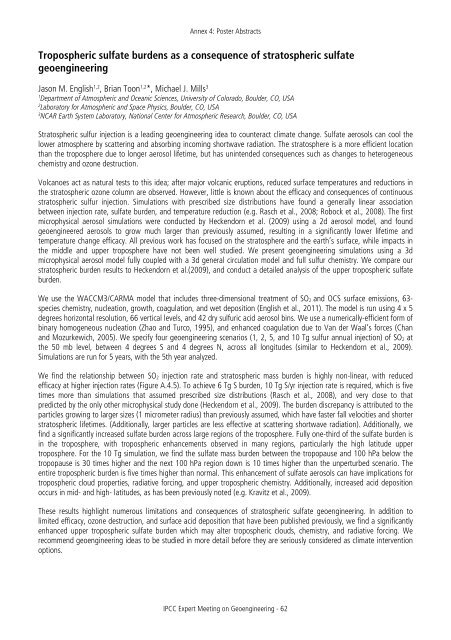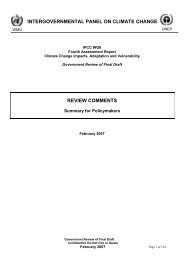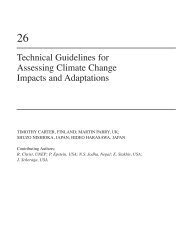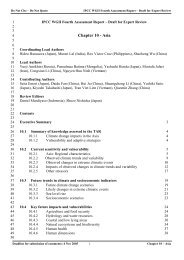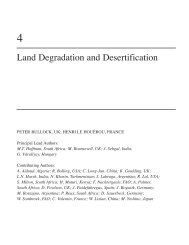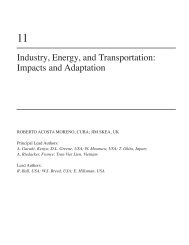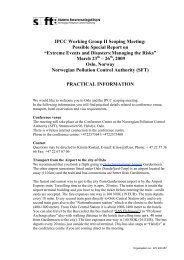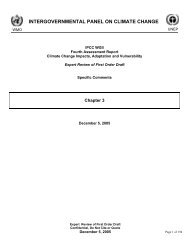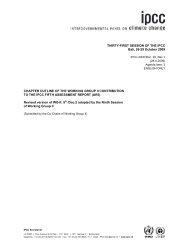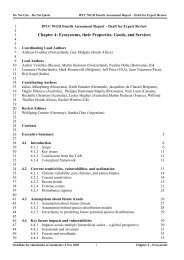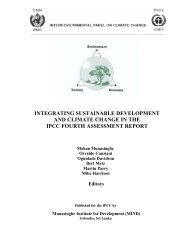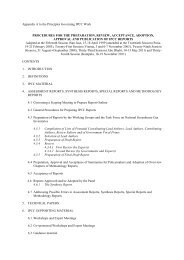IPCC Expert Meeting on Geoengineering
IPCC Expert Meeting on Geoengineering
IPCC Expert Meeting on Geoengineering
You also want an ePaper? Increase the reach of your titles
YUMPU automatically turns print PDFs into web optimized ePapers that Google loves.
Annex 4: Poster Abstracts<br />
Tropospheric sulfate burdens as a c<strong>on</strong>sequence of stratospheric sulfate<br />
geoengineering<br />
Jas<strong>on</strong> M. English 1,2 , Brian To<strong>on</strong> 1,2 *, Michael J. Mills 3<br />
1<br />
Department of Atmospheric and Oceanic Sciences, University of Colorado, Boulder, CO, USA<br />
2<br />
Laboratory for Atmospheric and Space Physics, Boulder, CO, USA<br />
3<br />
NCAR Earth System Laboratory, Nati<strong>on</strong>al Center for Atmospheric Research, Boulder, CO, USA<br />
Stratospheric sulfur injecti<strong>on</strong> is a leading geoengineering idea to counteract climate change. Sulfate aerosols can cool the<br />
lower atmosphere by scattering and absorbing incoming shortwave radiati<strong>on</strong>. The stratosphere is a more efficient locati<strong>on</strong><br />
than the troposphere due to l<strong>on</strong>ger aerosol lifetime, but has unintended c<strong>on</strong>sequences such as changes to heterogeneous<br />
chemistry and oz<strong>on</strong>e destructi<strong>on</strong>.<br />
Volcanoes act as natural tests to this idea; after major volcanic erupti<strong>on</strong>s, reduced surface temperatures and reducti<strong>on</strong>s in<br />
the stratospheric oz<strong>on</strong>e column are observed. However, little is known about the efficacy and c<strong>on</strong>sequences of c<strong>on</strong>tinuous<br />
stratospheric sulfur injecti<strong>on</strong>. Simulati<strong>on</strong>s with prescribed size distributi<strong>on</strong>s have found a generally linear associati<strong>on</strong><br />
between injecti<strong>on</strong> rate, sulfate burden, and temperature reducti<strong>on</strong> (e.g. Rasch et al., 2008; Robock et al., 2008). The first<br />
microphysical aerosol simulati<strong>on</strong>s were c<strong>on</strong>ducted by Heckendorn et al. (2009) using a 2d aerosol model, and found<br />
geoengineered aerosols to grow much larger than previously assumed, resulting in a significantly lower lifetime and<br />
temperature change efficacy. All previous work has focused <strong>on</strong> the stratosphere and the earth’s surface, while impacts in<br />
the middle and upper troposphere have not been well studied. We present geoengineering simulati<strong>on</strong>s using a 3d<br />
microphysical aerosol model fully coupled with a 3d general circulati<strong>on</strong> model and full sulfur chemistry. We compare our<br />
stratospheric burden results to Heckendorn et al.(2009), and c<strong>on</strong>duct a detailed analysis of the upper tropospheric sulfate<br />
burden.<br />
We use the WACCM3/CARMA model that includes three-dimensi<strong>on</strong>al treatment of SO 2 and OCS surface emissi<strong>on</strong>s, 63-<br />
species chemistry, nucleati<strong>on</strong>, growth, coagulati<strong>on</strong>, and wet depositi<strong>on</strong> (English et al., 2011). The model is run using 4 x 5<br />
degrees horiz<strong>on</strong>tal resoluti<strong>on</strong>, 66 vertical levels, and 42 dry sulfuric acid aerosol bins. We use a numerically-efficient form of<br />
binary homogeneous nucleati<strong>on</strong> (Zhao and Turco, 1995), and enhanced coagulati<strong>on</strong> due to Van der Waal’s forces (Chan<br />
and Mozurkewich, 2005). We specify four geoengineering scenarios (1, 2, 5, and 10 Tg sulfur annual injecti<strong>on</strong>) of SO 2 at<br />
the 50 mb level, between 4 degrees S and 4 degrees N, across all l<strong>on</strong>gitudes (similar to Heckendorn et al., 2009).<br />
Simulati<strong>on</strong>s are run for 5 years, with the 5th year analyzed.<br />
We find the relati<strong>on</strong>ship between SO 2 injecti<strong>on</strong> rate and stratospheric mass burden is highly n<strong>on</strong>-linear, with reduced<br />
efficacy at higher injecti<strong>on</strong> rates (Figure A.4.5). To achieve 6 Tg S burden, 10 Tg S/yr injecti<strong>on</strong> rate is required, which is five<br />
times more than simulati<strong>on</strong>s that assumed prescribed size distributi<strong>on</strong>s (Rasch et al., 2008), and very close to that<br />
predicted by the <strong>on</strong>ly other microphysical study d<strong>on</strong>e (Heckendorn et al., 2009). The burden discrepancy is attributed to the<br />
particles growing to larger sizes (1 micrometer radius) than previously assumed, which have faster fall velocities and shorter<br />
stratospheric lifetimes. (Additi<strong>on</strong>ally, larger particles are less effective at scattering shortwave radiati<strong>on</strong>). Additi<strong>on</strong>ally, we<br />
find a significantly increased sulfate burden across large regi<strong>on</strong>s of the troposphere. Fully <strong>on</strong>e-third of the sulfate burden is<br />
in the troposphere, with tropospheric enhancements observed in many regi<strong>on</strong>s, particularly the high latitude upper<br />
troposphere. For the 10 Tg simulati<strong>on</strong>, we find the sulfate mass burden between the tropopause and 100 hPa below the<br />
tropopause is 30 times higher and the next 100 hPa regi<strong>on</strong> down is 10 times higher than the unperturbed scenario. The<br />
entire tropospheric burden is five times higher than normal. This enhancement of sulfate aerosols can have implicati<strong>on</strong>s for<br />
tropospheric cloud properties, radiative forcing, and upper tropospheric chemistry. Additi<strong>on</strong>ally, increased acid depositi<strong>on</strong><br />
occurs in mid- and high- latitudes, as has been previously noted (e.g. Kravitz et al., 2009).<br />
These results highlight numerous limitati<strong>on</strong>s and c<strong>on</strong>sequences of stratospheric sulfate geoengineering. In additi<strong>on</strong> to<br />
limited efficacy, oz<strong>on</strong>e destructi<strong>on</strong>, and surface acid depositi<strong>on</strong> that have been published previously, we find a significantly<br />
enhanced upper tropospheric sulfate burden which may alter tropospheric clouds, chemistry, and radiative forcing. We<br />
recommend geoengineering ideas to be studied in more detail before they are seriously c<strong>on</strong>sidered as climate interventi<strong>on</strong><br />
opti<strong>on</strong>s.<br />
<str<strong>on</strong>g>IPCC</str<strong>on</strong>g> <str<strong>on</strong>g>Expert</str<strong>on</strong>g> <str<strong>on</strong>g>Meeting</str<strong>on</strong>g> <strong>on</strong> <strong>Geoengineering</strong> - 62


